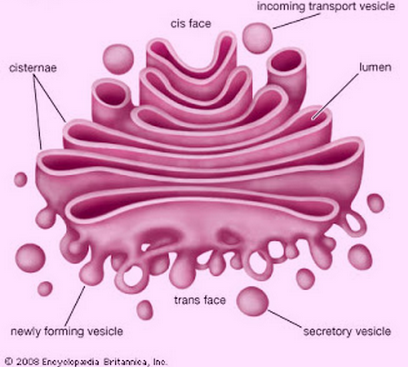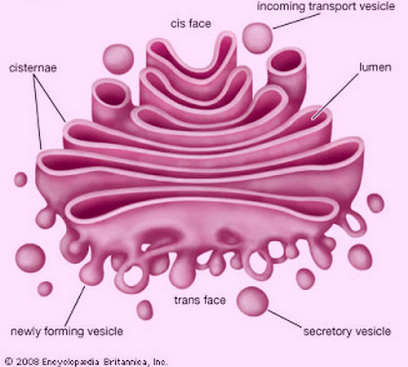The Golgi apparatus is a structure that is made of several flaps and is essential in the survival of the body cells. It helps the cells to transport proteins and other macromolecules, and also plays a crucial role in the prevention of apoptosis, the destruction of the cells. Camilio Golgi is the person, who discovered this apparatus, and it is found in all eukaryotic cells i.e. cells that have a nucleus and other structures enclosed in a membrane.
What is the structure of the Golgi apparatus?
The structure of the Golgi apparatus is made of flaps of membranes which are also called, Cisternae. These flaps occur in a series of 5 or 8 flaps, and they perform the function of moving proteins using enzymes. Each protein is properly labeled through the addition of carbohydrates and phosphates to be taken to the appropriate parts of the cell. The Golgi is able to perform this function by using nucleotide sugars which it is given by the cytosol. It is unclear how the proteins and vesicles move through the Golgi apparatus, but many have come up with theories about that. The vesicular transport theory says that the Golgi apparatus has two ends, the cis, and trans ends, and macromolecules are passed on through membrane sections. Another theory, the Cisternal maturation model, says that the vesicle fuse together at the cis end, and the macromolecules are pushed along as the vesicles continue to fuse.

What is the function of the Golgi apparatus?
The goggle apparatus plays the function of transporting the macromolecules that are required in the cells for them to work properly. The macromolecules are processed and packaged in a manner that the cells can make use of them. The Golgi apparatus is also the one that transports macromolecules for secretion. At first, it processes the proteins that are sent from the endoplasmic reticulum. However, it also transports any lipids that the cell may need. The Golgi apparatus works with other critical players in the endomembrane system of eukaryotic cells.
The Golgi apparatus also produces what is known as glycosaminoglycans, and these are required by the cells that form connective tissue. It uses a xylose link to polymerize the glycosaminoglycans onto proteins to form proteoglycan. The Golgi then goes ahead and provides a negative charge to the molecules by performing sulfation onto the proteoglycans so that they get signal abilities.
Vesicular Transport Model
This model assumes that the vesicles leave the rough endoplasmic reticulum, and move to the cis end of the apparatus, where they are fused together. It says that upon fusing the vesicles empty their contents into the lumen. It is in the lumen where the sorting occurs and then they are transported to various places in the cell. The Golgi apparatus is quite large, and is in larger numbers in cells that synthesize and secrete substances, e.g. The cells that produce antibodies and the plasma B cells.
The Cisternal Maturation Model
This model assumes that the cisternae move by being manufactured at the cis face, and then destroyed at the trans face. The model says that the vesicles from the rough endoplasmic reticulum fuse at the cis face of the Golgi apparatus to form a single cisternus at this end. This model gets support from the microscopic observation of structures larger than the transport vesicles moving through the Golgi apparatus. Although this was the first and popular theory, it was almost discarded in the 1980’s. However, it has made a comeback since new research has evidence that clearly shows Golgi apparatus compartments maturing.
What happens to the Golgi apparatus during mitosis?
When mitosis happens in animal cells, the Golgi apparatus simply breaks up and disappears. Once the cell has reached the telophase of mitosis, a new Golgi apparatus appears in each new cell. It is not clear how this occurs, and there were no theories by December 2009. However, in yeast and plant cells, the Golgi apparatus remains intact throughout the process of mitosis. Nobody knows why this happens, but scientists have put forth a theory that this may be due to the Golgi protein difference in the cells of animals and plants.
The transformation of molecules has been said to happen as the molecule travels across the cisternae. One can liken this to a maze of tumblers in which the molecule travels, and is transformed by the enzymes and finally directed to the part of the cell where it is required. A lot of research is going into understanding the Golgi apparatus, which has proven to be a crucial organelle inside a cell. Without the Golgi apparatus, the cells would not get nutrients, and it would also not be able to secrete waste products. This means that the Golgi apparatus is very important in the sustenance of life as people know it.
